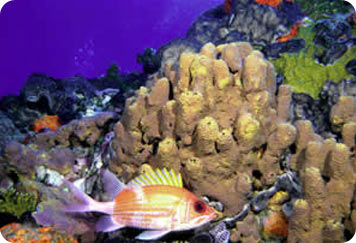If you’ve ever spent an afternoon at the beach without your sunscreen, then you’re all too familiar with the Sun’s ultraviolet radiation -- it was responsible for that nasty sunburn.
 Ultraviolet light may harm marine life. Credit: National Oceanic and Atmospheric Administration
Ultraviolet light may harm marine life. Credit: National Oceanic and Atmospheric AdministrationUltraviolet has a shorter wavelength than visible light, so we can’t see it. But it’s more penetrating -- it can zap right through individual cells. As a result, we feel ultraviolet’s effects. It’s responsible for that nice golden suntan -- and the skin cancers that can follow. It can also cause genetic mutations -- not just to life on land, but to life in the oceans as well.
Most ultraviolet is blocked by Earth’s ozone layer. But as the ozone layer has thinned in recent decades, more of it is reaching the surface and penetrating the water. Most is absorbed in the top 10 feet or so, but some can penetrate to depths of a couple of hundred feet.
Many studies have shown that ultraviolet can harm marine life. It can slow down the rate of photosynthesis in the microscopic plants in the surface layers that form the first link in the ocean food chain. It can harm the reproduction and development of larger organisms like fish. And it can kill the small organisms that give coral its color.
But other studies have shown that extra ultraviolet could also have some positive effects. Coral skeletons, for example, may not only absorb the energy, but thrive in it. And in tropical waters, extra ultraviolet energy can even boost the rate of photosynthesis -- yielding more life from an otherwise nasty form of energy.

